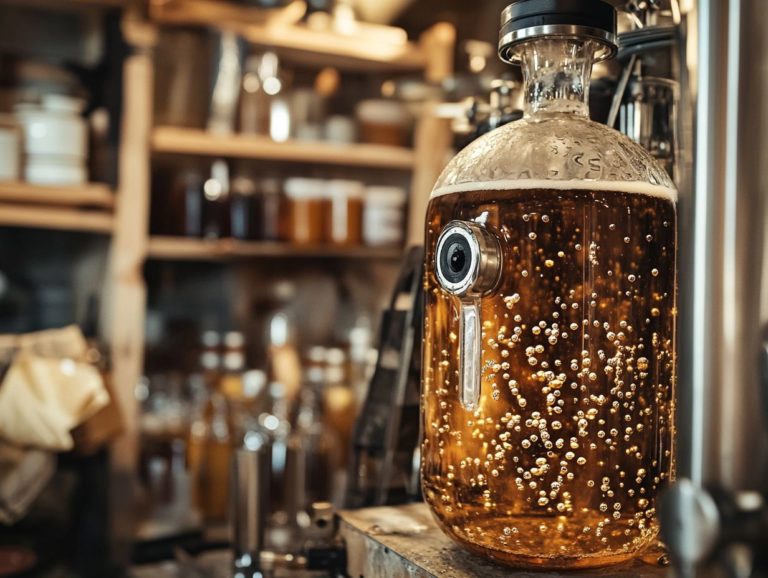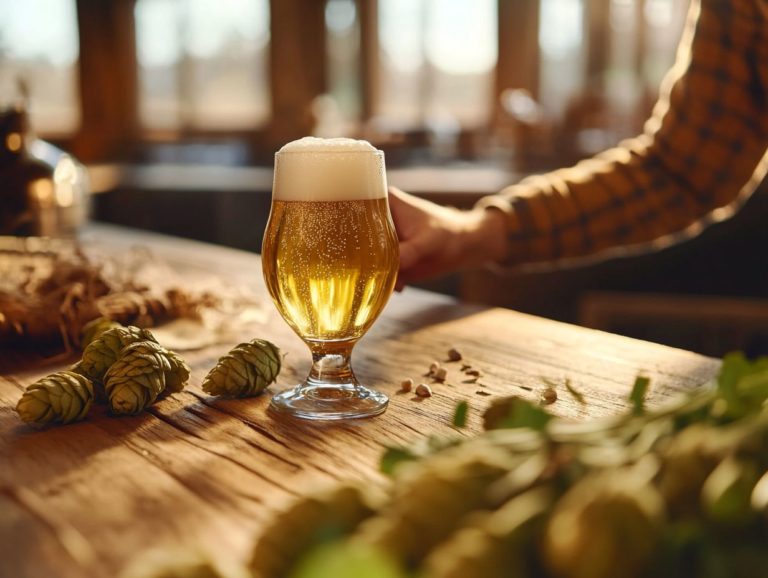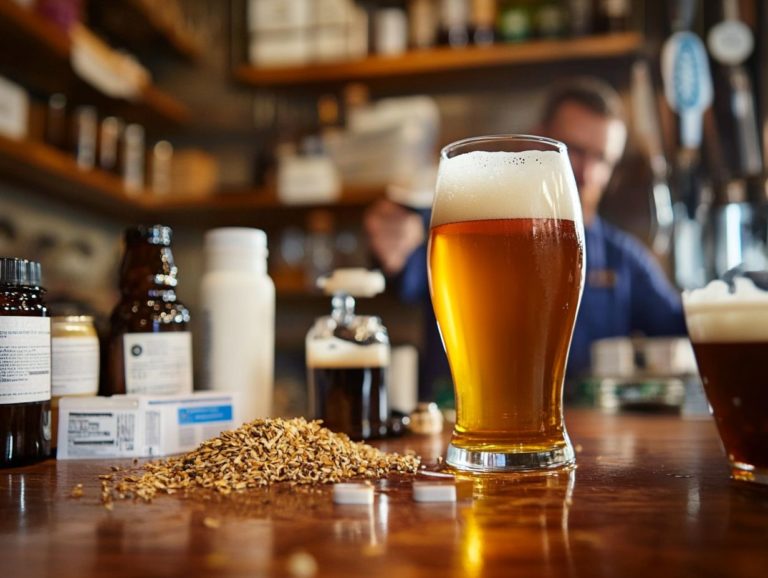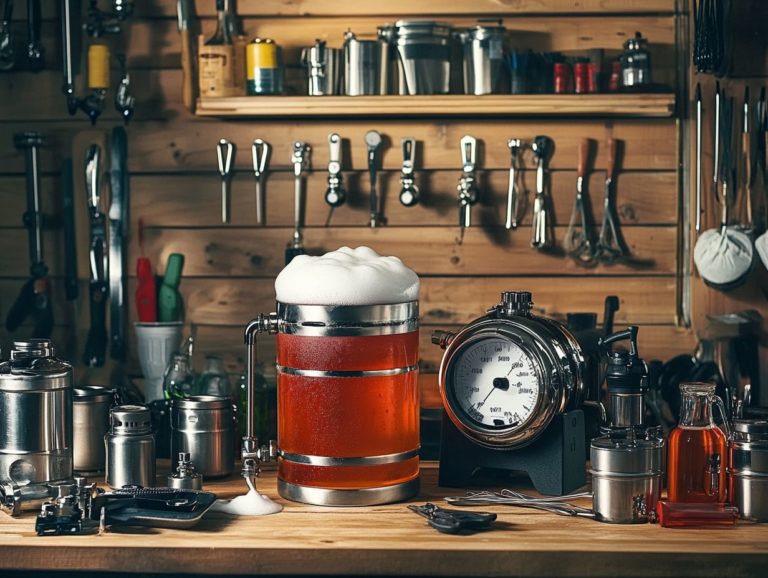Fixing Off-Flavors from Poor Storage
Off-flavors, like diacetyl, can ruin your favorite meals, diminishing the pleasure of your culinary creations. Understanding what causes these undesirable tastes is essential for every home cook and food enthusiast.
This article explores common off-flavors, the effects of inadequate storage, and how to spot signs of spoilage, such as changes in specific gravity or grain crush issues.
You will discover practical solutions to remedy and prevent these flavors, ensuring your meals remain a delightful experience. Get ready to rediscover the amazing flavors of your favorite dishes!
Contents
- Key Takeaways:
- Causes of Off-Flavors in Food
- Impact of Poor Storage on Food Flavors
- What Factors Contribute to Poor Storage?
- What Are the Signs of Poorly Stored Food?
- How to Fix Off-Flavors from Poor Storage?
- 1. Properly Store Food
- 2. Use Fresh Ingredients
- 3. Add Flavours to Mask Off-Flavours
- How to Prevent Off-Flavors from Poor Storage in the Future?
- Frequently Asked Questions
- What are some common mistakes people make when storing food and drinks?
- Can off-flavors be harmful to consume?
- Can off-flavors be fixed for all types of food and drinks?
Key Takeaways:
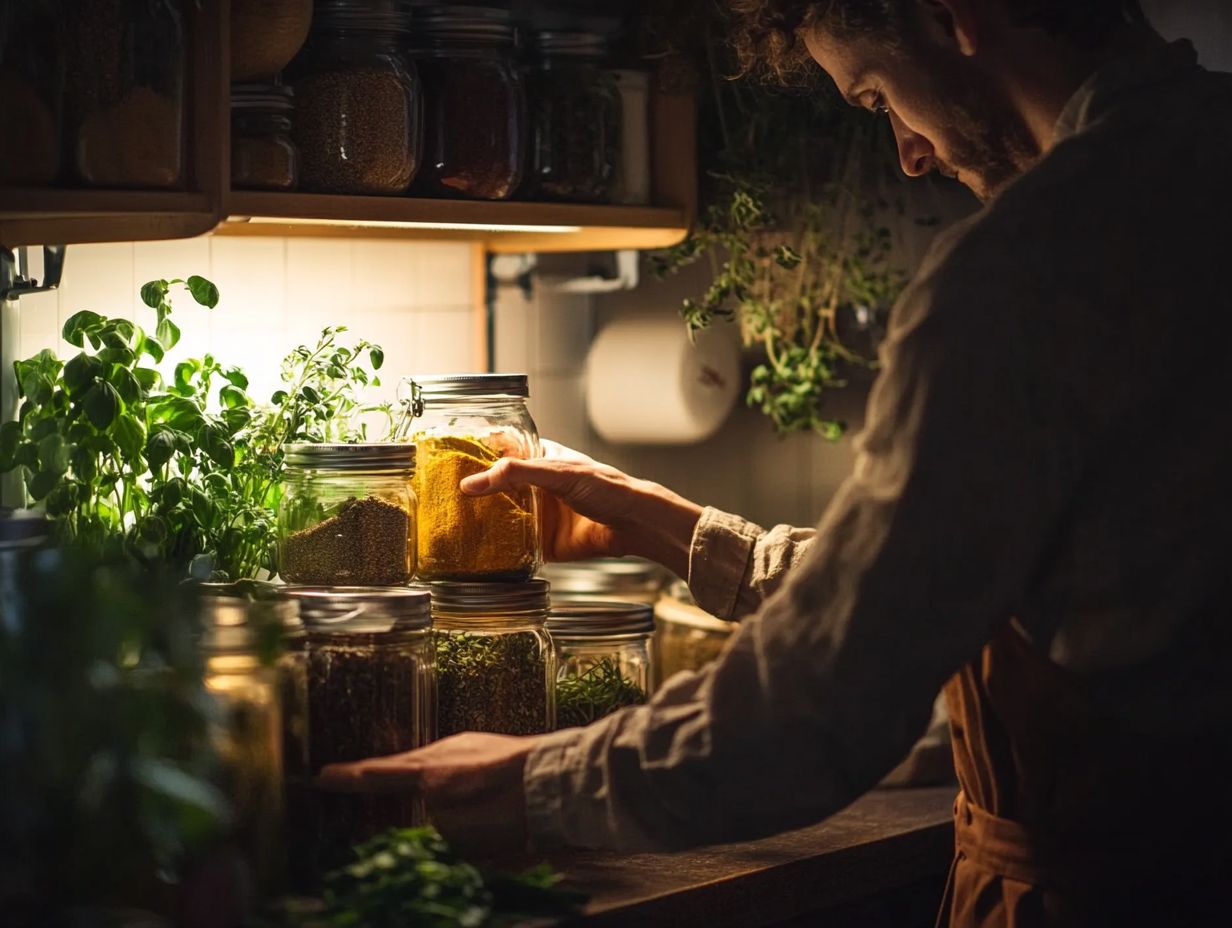
- Store food properly to prevent off-flavors from poor storage.
- Use fresh ingredients and cooking techniques to enhance flavor.
- Check for spoilage and use airtight containers to prevent off-flavors.
Causes of Off-Flavors in Food
Off-flavors in food can arise from various factors, such as improper brewing processes, suboptimal fermentation temperatures, and the overall health of the yeast. Each of these elements can significantly impact the flavor profiles of your dishes. For instance, using a pH meter helps you monitor and control these factors.
Understanding these causes is crucial for both professional chefs and passionate homebrewers, as it enables you to achieve the consistency and quality desired in your brewing batches. Different brewing methods, like dry-hopping techniques or specific yeast nutrients, can also influence the emergence of off-flavors, underscoring the importance of early detection and intervention in the brewing process.
What Are the Most Common Off-Flavors?
Common off-flavors can be quite an unwelcome surprise, especially when considering the complexities of beer flavors and brewing chemistry. You might encounter diacetyl, which brings a buttery taste that can easily overpower your dish; oxidation issues that leave a stale, cardboard-like flavor; astringency that creates a dry mouthfeel; musty flavors signaling poor storage; and undesirable alcohol notes that can easily overwhelm your palate, particularly in brewing.
These off-flavors stem from various factors, including the quality of ingredients, processing methods, and storage conditions. For example, diacetyl often appears in under-fermented dairy products or poorly handled popcorn, taking over the entire flavor profile, similar to its impact in an improperly brewed lager. Oxidation, a frequent issue with oils and nuts, happens when these products are exposed to light and air, leading to unpleasant, rancid notes reminiscent of a damp basement, echoing oxidation issues in brewing.
Astringency typically arises from over-brewed teas or certain red wines, creating a dryness that disrupts your tasting experience and masks other desirable flavors, mirroring astringency problems in beer. Musty notes, often found in improperly stored grains or spices, indicate moisture problems compromising freshness, similar to musty flavors in brewing. Lastly, excessive alcohol presence in poorly balanced sauces or beverages can create a harshness that detracts from the harmonious taste you’re aiming for.
Impact of Poor Storage on Food Flavors
The conditions in which you store food can significantly influence its flavors, fostering the growth of unwanted bacteria and causing fermentation problems that can ruin your carefully selected brewing ingredients, like those used in a tripel batch.
Inadequate temperature control and humidity levels, combined with unclean equipment, can intensify these issues, ultimately jeopardizing the quality and taste of your stored foods, similar to concerns in brewing.
Just as proper water treatment is crucial in brewing, understanding how storage impacts food flavors is vital for both homebrewers and culinary aficionados, ensuring consistent results.
What Factors Contribute to Poor Storage?
Several factors contribute to poor food storage, including inadequate temperature control, improper water treatment, and insufficient fermentation cleanliness all critical in the brewing steps. These issues can lead to undesirable off-flavors and spoilage. Neglecting proper bottle cleaning risks introducing contaminants that affect the taste and safety of your food products.
Temperature control is absolutely crucial for preserving flavors and textures. For example, storing wine at too warm a temperature can accelerate oxidation, the chemical process that can spoil flavors, resulting in a flat and uninviting taste profile.
In culinary contexts, improperly stored produce can decay more quickly, robbing it of vital nutrients and resulting in textures that are less than appetizing.
Using unfiltered water in brewing introduces unseen impurities, leading to unwanted aftertastes that overshadow the intended flavors of the final product and complicate your brewing experiences.
A lack of rigorous cleanliness during fermentation can allow wild yeasts or bacteria to take hold, imparting funky flavors that might not be to everyone s liking and potentially jeopardizing the entire batch, as noted in many brew descriptions.
Each of these factors plays a significant role in determining how food and beverages ultimately taste and how safely they can be enjoyed, whether it s a tripel, lager, or any other style of beer.
What Are the Signs of Poorly Stored Food?
Signs of poorly stored food can manifest in various ways, such as an off-flavor profile, visible spoilage, changes in texture, and carbonation issues, similar to those experienced in brewing observations. These indicators signal that the food has deteriorated or fermented incorrectly. Recognizing these signs is crucial to keep your culinary and brewing creations at their best, especially when preparing for a homebrew competition.
When food surprises you with unexpected sourness or rancidity, those off-flavors often reveal improper storage conditions like excessive moisture or inadequate temperatures, which can lead to fermentation mishaps similar to those in brewing batches. Describing your sensory experience can be incredibly valuable; for example, if you notice a slimy texture on vegetables or unusual gas escaping from a sealed container, these could be clear signs of microbial spoilage, comparable to fermentation issues detected in beer.
Understanding the delicate balance of time, temperature, and environment during food storage is key for troubleshooting and correcting potential fermentation issues while maintaining brewing consistency. You must inspect your food closely to avoid health risks associated with consuming compromised food products, similar to brewing advice for maintaining beer quality.
How to Fix Off-Flavors from Poor Storage?

To rectify off-flavors arising from inadequate storage, you should adopt a range of strategies, including those used to address brewing measurements and adjustments. Begin by incorporating fresh ingredients, making necessary brewing adjustments, and employing proper brewing techniques to restore balance to the flavors. Consider using Star San for sanitization.
Understanding flavor detection methods will empower you to identify specific off-flavors and effectively guide your corrective actions, similar to the precision required in monitoring specific gravity during brewing.
1. Properly Store Food
One of the most effective ways to prevent off-flavours in your food is by mastering proper storage techniques. These techniques maintain ideal temperature and humidity levels, much like the precision required in the brewing process during fermentation, especially in lager fermentation.
Protect your ingredients from light and temperature changes. Just like brewers guard their hops and malts, use airtight containers and store perishables in cool, dark places.
Understanding the unique characteristics of certain foods like how sensitive dairy products and herbs are to air exposure dramatically boosts the freshness and flavour of your stored items. By adopting these best practices, you not only preserve freshness but also reflect the meticulous care that goes into crafting a fine brew.
2. Use Fresh Ingredients
Using fresh ingredients is essential for enhancing flavour profiles and minimizing off-flavours, as noted in many brewing experiences. Outdated or spoiled ingredients can seriously compromise the quality of your culinary creations and beverages, including beer, highlighting the importance of yeast health.
The choice of ingredients can make or break your dish, impacting the overall beer notes and brew descriptions. Fresh produce and herbs bring a vibrancy and depth that stale or processed alternatives simply cannot match.
When you embark on the brewing journey, the path to flavorful beer begins with freshly harvested hops and malt grains. These ingredients influence aroma and shape the overall taste experience, contributing to distinct beer flavours.
Understanding the importance of sourcing seasonal ingredients allows you to support local agriculture while ensuring that every bite or sip is infused with the essence of “farm to table,” a concept embraced in brewing suggestions for fresh hops. This approach leads to more authentic and memorable flavours in your creations, aligning with brewing advice for top-notch beer.
By incorporating fresh components, you elevate the palate, introducing a dynamic range of aromas and textures essential for crafting truly exceptional dishes and beverages, akin to brewing experiences with high-quality ingredients.
3. Add Flavours to Mask Off-Flavours
When off-flavours have already made their unwelcome appearance, add complementary flavours to rescue your dish! Much like certain brewing techniques balance out unwanted notes through careful flavour identification and adjustments, you can elevate your kitchen creations.
For instance, if you find sulfur notes creeping into your beer, a touch of malty sweetness or fruity esters can work wonders in softening those harsh edges. Off-flavours in beer, such as diacetyl (which gives a buttery flavour) or astringency, may require specific brewing adjustments.
In the kitchen, you may often encounter the challenge of overpowering bitterness in your dishes. To counteract this, a splash of acidity, like lemon juice or a dash of vinegar, can create a more harmonious balance that elevates the overall flavour profile.
Introducing spices such as cinnamon or vanilla can enhance your desserts, skillfully masking any raw flour taste in baked goods. By employing these thoughtful strategies, you not only elevate your culinary creations but also demonstrate the significance of artful flavour pairing.
In brewing, using specific hops like Saaz or Hallertauer Mittelfrueh can also refine the flavour profiles of your beer.
Use Cooking Techniques to Improve Flavor
Employing specific cooking techniques can significantly enhance flavor. Certain methods elevate the natural tastes of ingredients or help mitigate off-flavors, much like how specific brewing methods can refine beer quality. For instance, the way lagers are fermented or managing fermentation temperature can profoundly affect the resulting beer flavors.
Consider techniques such as roasting or searing. These techniques can unlock the sweetness in vegetables while developing a rich, caramelized crust on meats. Brining boosts moisture retention and infuses flavor deep within proteins, resulting in an irresistibly tender texture. In brewing, using a proper grain crush ensures maximum extraction efficiency.
In the brewing realm, the temperature choice during the mashing process can dramatically impact the beer’s profile. It affects its bitterness and aroma. By grasping these culinary practices, you can craft dishes and beverages that are not only vibrant but also thoroughly satisfying, appealing to a broader spectrum of palates.
Try Alternative Cooking Methods
Exploring alternative cooking methods can truly unlock new dimensions of flavor. Just as innovative brewing techniques unveil unique characteristics in beer, alternative cooking methods allow you to express your creativity while stepping away from traditional techniques. Consider sous-vide cooking or smoking; these methods can profoundly transform the flavor profile of a dish, akin to how different yeast strains can alter the taste of beer.
Sous-vide cooking retains moisture and intensifies flavors, resulting in perfectly tender meats. Meanwhile, smoking brings an alluring complexity through the infusion of aromatic woods. Similarly, brewers often embrace barrel aging or dry hopping methods that add rich layers and captivating aromas to their beers.
Using yeast nutrients and maintaining yeast health are also crucial steps in creating unique beer flavors. These approaches demonstrate how embracing alternative techniques can lead to delightful culinary discoveries, inspiring both the home chef and the passionate brewer to elevate their craft.
How to Prevent Off-Flavors from Poor Storage in the Future?
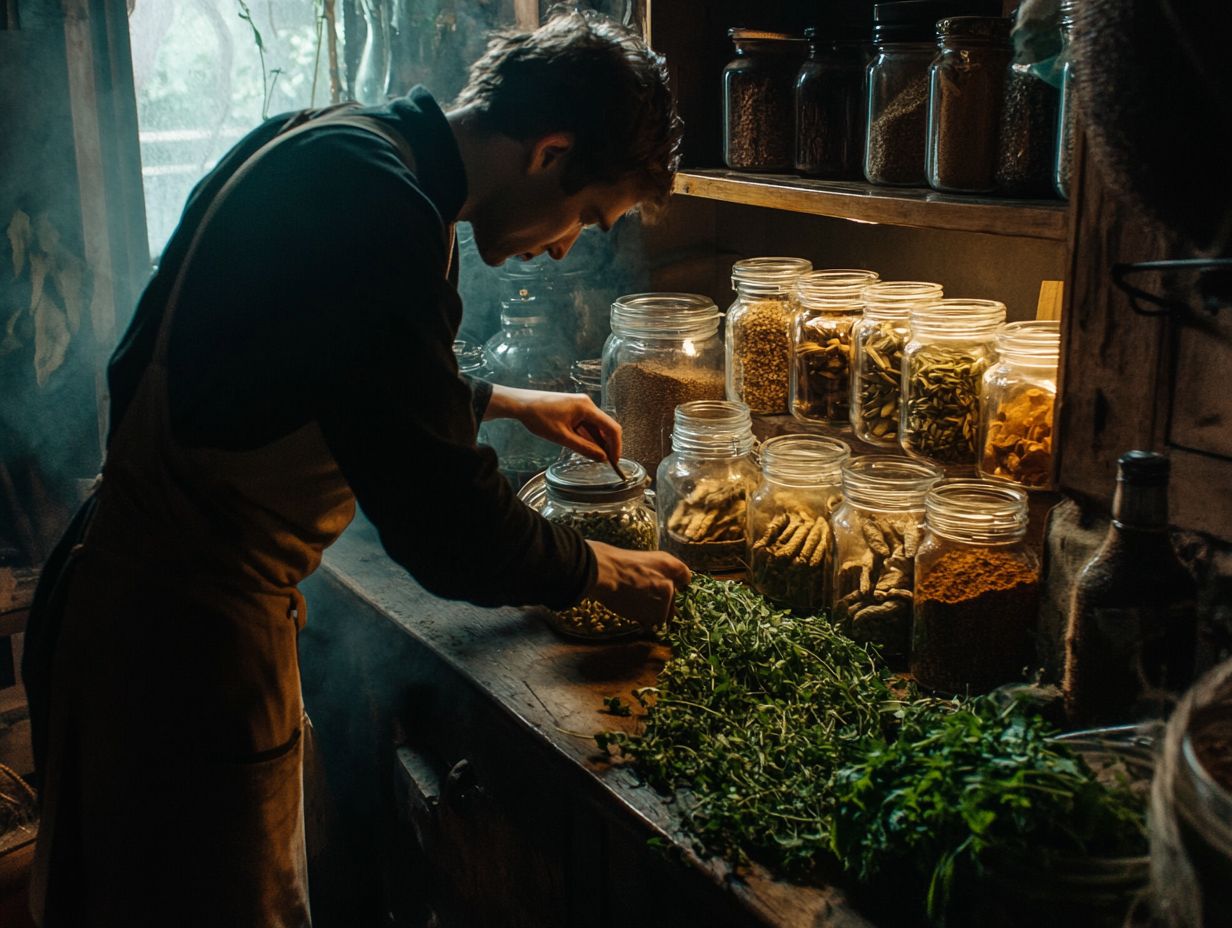
To prevent off-flavors caused by inadequate storage, take charge with a proactive approach. This includes implementing proper storage practices, maintaining cleanliness during fermentation, and following brewing suggestions that promote exceptional quality in both food and beverage preparation. For instance, using a pH meter to check acidity levels can help maintain quality.
By taking these steps, you can ensure a delightful experience in every sip and bite.
Proper Food Storage Techniques
Proper food storage is crucial for maintaining quality and safety. Here are some key practices to follow.
1. Store Food Properly
Implementing proper storage techniques is essential for ensuring both food safety and quality.
By keeping foods at optimal temperatures and conditions, you can maintain their integrity, much like the meticulous management of brewing equipment during beer production.
Using brewing consistency and water treatment ensures that the final product remains of high quality.
Just as brewers carefully monitor fermentation temperatures and sanitize their tanks to produce a consistent product, your approach to food storage requires vigilance and adherence to established guidelines.
Keep your refrigerator below 40 F to prevent bacterial growth and utilize airtight containers to prevent cross-contamination.
Proper bottle cleaning techniques are also essential in both food and beverage storage to avoid contamination.
Similar to managing yeast cultures in brewing, understanding the temperature requirements for different food types such as meats, dairy, and produce is crucial.
Labeling and organizing your food items can further enhance storage efficiency, making it easier for you to track freshness and minimize waste.
This approach mirrors the systematic methods brewers employ to inventory their ingredients, ensuring that everything is in its right place for optimal results.
2. Check for Signs of Spoilage
Imagine enjoying fresh, flavorful meals every day! Here s how to ensure that happens.
Regularly checking for signs of spoilage, like detecting off-flavors and noticing changes in texture, is essential for maintaining food quality and preventing any negative impacts on taste.
Detecting off-flavors can be performed using various methods, such as sensory evaluation or chemical analysis.
Employing various methods to identify these indicators can greatly enhance the overall safety and enjoyment of your food and beverages.
Techniques such as sensory evaluation, where trained panelists assess flavor and aroma, are crucial in spotting those subtle off-flavors that might slip past the average consumer.
Chemical analysis methods, like using a pH meter or gas chromatography (a technique that separates and analyzes compounds), can accurately pinpoint spoilage compounds.
Additionally, monitoring storage conditions such as temperature and humidity is vital to thwart microbial growth and protect the integrity of your food.
By integrating these strategies, you ensure that you re always presented with fresh and flavorful offerings.
3. Use Airtight Containers
Want to keep your food tasting great? Airtight containers are your best friend!
Using airtight containers for food storage dramatically enhances flavor preservation by preventing exposure to air and moisture, both of which can cause off-flavors and spoilage.
In brewing, maintaining proper sealing during the bottling process can prevent oxidation issues.
When you seal your food properly, it retains its original taste and freshness for an impressively extended period.
Take spices, for instance; when stored in airtight jars, they maintain their aromatic properties, ensuring that every meal is a burst of vibrant flavors.
Using Star San during the cleaning process ensures that your brewing equipment remains sanitized, preserving the original taste and freshness of your beer.
Leftovers, too, thrive in airtight containers not only do they remain safe from contamination, but their original taste nuances are preserved, making them enjoyable even days later.
This effective barrier against air also combats the staleness that often plagues crackers and cookies, allowing your snacks to retain that freshly baked crunch.
Choosing the right storage solutions can greatly enhance your food experience, keeping it flavorful and delightful.
4. Monitor Temperature and Humidity
Effectively monitoring temperature and humidity levels is essential for maintaining food quality and preventing off-flavors that may develop from inadequate storage conditions. Control during fermentation is crucial for quality.
Temperature fluctuations can wreak havoc, leading to spoilage in sensitive products like meats, dairy, and produce, which react adversely to environmental changes. Proper humidity control is equally important, especially for baked goods and dried fruits. Too much moisture can encourage mold growth and ruin texture.
Consider cheese; it flourishes in a cooler, controlled environment that preserves its integrity and flavor. On the other hand, fruits and vegetables thrive at specific humidity levels, significantly extending their shelf life.
By adopting systematic monitoring practices, you can protect your inventory and enhance customer satisfaction through outstanding food quality. Using a gravity meter a tool used in brewing to measure the density of liquid ensures accurate monitoring of fermentation details.
5. Rotate Food Items
Rotating food items regularly is a simple yet effective strategy for maintaining freshness and preventing off-flavors. By using older items before newer ones, you maximize the lifespan of perishables and help reduce waste. In brewing, rotating batches helps maintain consistency and flavor profiles.
When you adhere to a system that moves items to the front of the shelf as they approach their use-by date, you create a more organized kitchen environment. This practice encourages a mindful approach to consumption, allowing you to enjoy a variety of flavors while minimizing spoilage risk.
Adopting this habit is crucial for enjoying the freshest, most flavorful ingredients in your meals, contributing to a healthier lifestyle.
Frequently Asked Questions
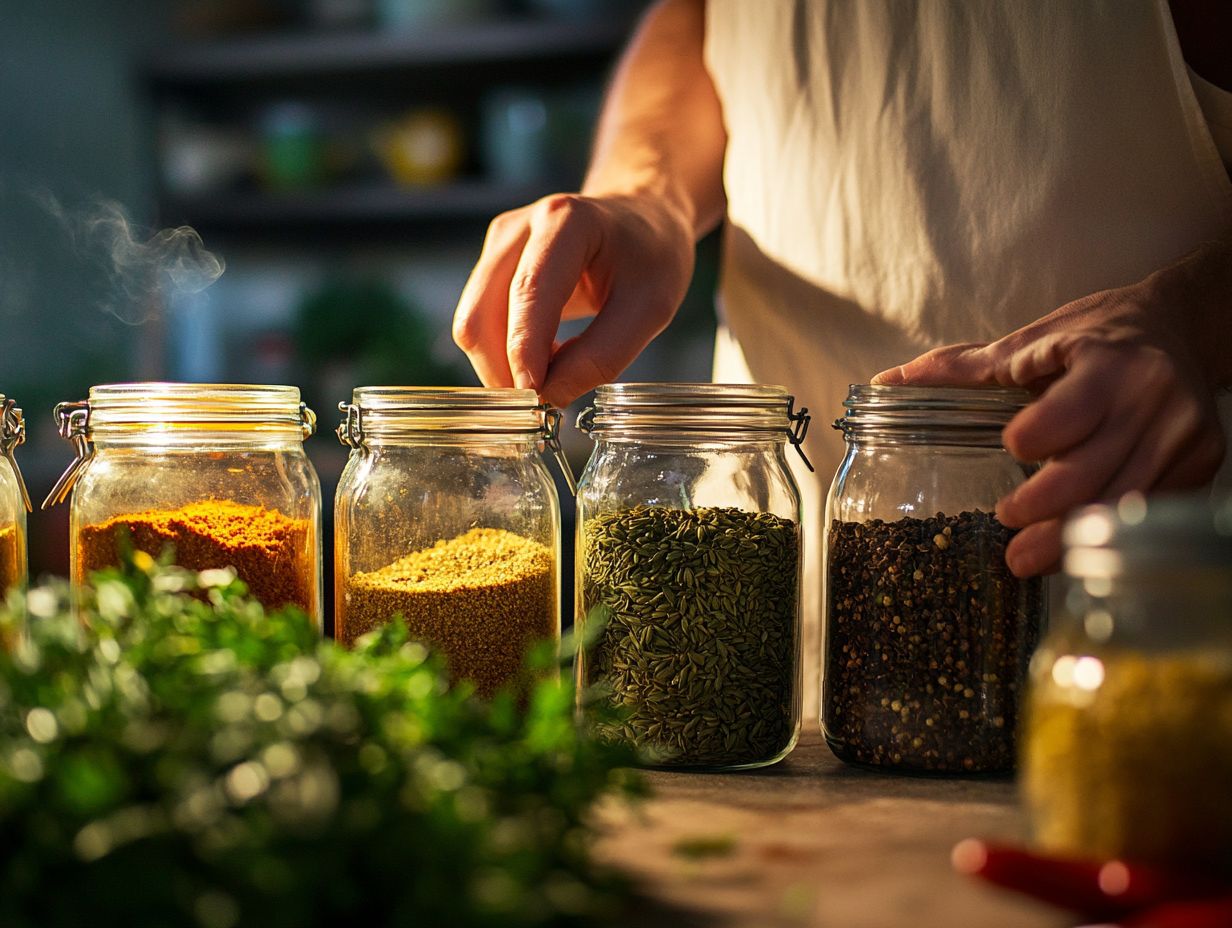
How can I fix off-flavors that have developed from poor storage?
If your food or drink has developed off-flavors due to poor storage, there are a few steps you can take to fix it. First, try rinsing the food or drink with cold water to remove the off-flavor. If that doesn’t work, add a few tablespoons of lemon juice or vinegar to neutralize the off-flavor. Fresh herbs or spices can also help mask the off-flavor. For homebrew, using Campden tablets a common brewing additive can help remove certain off-flavors.
What types of off-flavors can develop from poor storage?
Off-flavors can range from a sour or bitter taste to a rancid or metallic taste. These flavors can develop from various factors, including exposure to light, heat, or air, and improper storage temperature or moisture levels. Properly storing your food and drinks is crucial to prevent off-flavors. In brewing, diacetyl off-flavor and carbonation issues are common problems that can be mitigated with proper brewing steps.
How can I prevent off-flavors from developing in the first place?
Preventing off-flavors involves maintaining proper storage conditions, monitoring temperature and humidity levels, and using quality ingredients. In brewing, keeping a clean fermenter and using appropriate yeast strains like Wyeast can prevent musty flavors and other off-flavors from developing. Understanding beer chemistry and following brewing advice significantly mitigates the risk.
The best way to prevent off-flavors is to properly store your food and drinks. This means keeping them in airtight containers, away from direct sunlight, and at the correct temperature. Pay attention to expiration dates and avoid storing foods together that can cause cross-contamination.
What are some common mistakes people make when storing food and drinks?
Many people leave food and drinks out at room temperature for too long. Not sealing containers properly can also lead to issues, and storing flavors together may cause cross-contamination.
Are you reading the storage instructions on your food packaging carefully? Doing so can help keep your food fresh and tasty!
Can off-flavors be harmful to consume?
Off-flavors are usually safe to consume and can often be resolved with better storage. However, if you notice spoilage signs like mold or bad smells, throw it away to stay safe!
Can off-flavors be fixed for all types of food and drinks?
Most off-flavors can be corrected, but some situations are beyond help. If food has spoiled due to improper storage, it’s time to discard it. Some flavors can become too strong or pervasive to fix.

